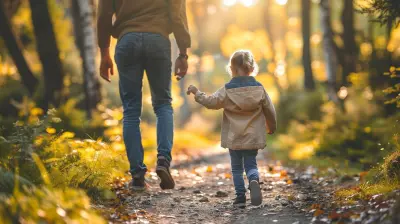The Connection Between Fine Motor Skills and Cognitive Growth
14 July 2025
Ever watched a baby struggle to pick up a tiny Cheerio and then celebrate like they just won Olympic gold? That small moment — a pincer grasp in action — isn’t just cute. It’s a tiny window into a much larger process going on inside their brains. Welcome to the fascinating and wildly underrated world of fine motor skills and how they tie into cognitive development.

What Are Fine Motor Skills, Exactly?
Let’s kick things off with the basics.Fine motor skills are those small, precise movements we make with our hands, fingers, wrists, toes, lips, and tongue. Think writing your name, buttoning a shirt, tying your shoes, or even typing this sentence. Anything that requires control and precision — that’s fine motor territory.
And while they might seem like simple milestones, they’re actually complex feats of coordination. It’s your brain telling your muscles what to do — and doing it well. That’s where the cognitive part sneaks in.

Cognitive Growth: More Than Just “Thinking”
When we talk about cognitive development, we’re not just talking about IQ or solving algebra problems. Cognitive growth covers a whole range of mental processes:- Attention
- Memory
- Learning
- Problem-solving
- Language
- Reasoning
- Planning and decision-making
So now you're probably wondering — what does buttoning a shirt have to do with memory or problem-solving? More than you might think.

How Fine Motor Skills and Cognitive Development Work Hand in Hand
Here’s the juicy part. These two processes — motor skills and brain growth — don’t happen in isolation. They influence each other like dance partners moving in sync.Brain Wiring and Skill Practice
Every time a child practices tying their shoes or stacking blocks, they’re doing more than improving hand coordination. They’re literally building brain connections — neural pathways that strengthen with repetition. And the better those pathways get, the stronger their memory, focus, and mental flexibility become.It’s kind of like a workout for the brain. Just like lifting weights builds muscle, practicing fine motor tasks builds mental “muscle” too.
Motor Skills as a Gateway to Learning
Imagine trying to write your name, but your fingers won’t cooperate. Frustrating, right? If a child struggles with fine motor control, it can hold them back in school and other learning environments. Writing, cutting with scissors, turning pages of a book — all of these are tied to academic success.So, when fine motor skills lag behind, cognitive learning can take a hit. On the flip side, when motor skills are well developed, it opens up a world of learning opportunities.
Multisensory Experience = Better Brain Development
Fine motor activities often involve multiple senses. Take playing with modeling clay, for example. You’re feeling it (touch), seeing it change shape (vision), maybe even smelling it (well, hopefully something non-toxic). This kind of sensory integration supercharges brain development.Basically, hands-on learning isn’t just a fun buzzword. It’s deeply rooted in how our brains work best.

Real-Life Examples of the Fine Motor–Cognition Link
Let’s bring this down into the real world. How does this connection show up in everyday life?1. Writing and Language Development
Handwriting is probably one of the most obvious fine motor skills — but it’s also tied directly to literacy. Kids who are better at writing often do better with reading and overall language development. Why? Because writing engrains letter recognition, spelling patterns, and even sentence structure into the brain.Ever kept a journal and found your thoughts got clearer as you wrote? That’s the fine motor–cognition connection in action.
2. Puzzles and Problem Solving
Remember those wooden puzzles you played with as a kid? At the time, it felt like a game. But underneath it, you were learning spatial awareness, logical thinking, and shape recognition — all cognitive skills — by using your hands to manipulate tiny pieces.That’s more than playtime. That’s brain training!
3. Drawing and Creative Thinking
Drawing and coloring are not just creative escapes — they’re cognitive exercises. They teach planning (what goes where?), decision-making (which color should I use?), and memory (how do I draw a cat again?). Plus, they require precise hand control.So grab that crayon. You’re making art for your brain, too.
4. Playing an Instrument
Musical instruments are a goldmine of fine motor and cognitive connections. You need finger dexterity, timing, memory, auditory processing, and focus — all at the same time. That’s a brain marathon.Stages of Development: When Do These Skills Emerge?
Fine motor and cognitive development follow a general timeline, though every child is unique. Here’s a quick breakdown:Infants (0–12 months)
- Reaches for toys- Grasps small objects
- Brings hands to mouth
- Begins to explore textures
The focus here is on sensory experiences. Babies learn through touch — every squeeze and squish influences how they understand the world.
Toddlers (1–3 years)
- Stacks blocks- Scribbles with crayons
- Begins self-feeding with utensils
Fine motor practice now supports early problem-solving, independence, and communication.
Preschoolers (3–5 years)
- Cuts with scissors- Draws shapes and letters
- Starts dressing independently
This stage is huge for school readiness. More motor control means they’re ready to write, build, experiment, and engage with peers.
School-Age Kids (6+ years)
- Refines handwriting- Types on keyboards
- Plays instruments or sports
Now, the brain starts applying these motor skills to academic and social tasks. Fine motor mastery helps boost confidence and success in new challenges.
Why This Connection Matters More Than Ever
With the rise of screens and less physical playtime, kids today may not be developing fine motor skills as robustly as previous generations. That’s not just a matter of physical ability — it could be affecting how they think, learn, and interact with the world.It’s not about banning screens altogether (we’re not monsters!), but we do need to make space for good old-fashioned play — the kind with sand, Play-Doh, crayons, and building blocks. These aren’t just toys — they’re tools for cognitive growth.
Supporting Fine Motor and Cognitive Development at Home
So, you’re probably wondering what you can do to support someone — maybe your child, or even yourself — in building these vital skills. Good news: it doesn’t require fancy tools or a degree in occupational therapy.Here are a few easy, brain-boosting activities:
Do More With Your Hands
- Sorting coins or buttons- Stringing beads
- Playing with putty or clay
- Pouring water from one cup to another
- Punching holes in paper with a hole puncher (seriously!)
These tasks seem small, but they engage memory, attention, and problem-solving, even for adults.
Build Together
- LEGOs, blocks, and construction sets- Puzzles of all kinds (jigsaws, mazes)
- Origami or paper folding
These aren’t just fun — they build spatial thinking and planning skills.
Encourage Drawing and Writing
- Journal entries, even a sentence or two- Comic strips or doodles
- Practicing letters or numbers with finger paint
Anything that combines creativity with hand movement is a win-win.
Get Cooking
- Stirring, pouring, measuring- Rolling dough or shaping cookies
- Using tongs or chopsticks
Cooking is secretly one of the best fine motor workouts — plus, you get a snack.
The Adult Connection: Fine Motor Skills Aren’t Just for Kids
Think cognitive and motor development only matter in childhood? Think again.Adults benefit from fine motor activities, too — especially when it comes to keeping the brain sharp. Enjoy knitting? Playing the piano? Woodworking? Those hobbies aren’t just relaxing — they’re giving your prefrontal cortex a little cardio.
In fact, many occupational therapists recommend fine motor exercises for older adults to stave off cognitive decline and improve dexterity.
Wrapping It Up: Small Movements, Big Impact
The connection between fine motor skills and cognitive growth is kind of like the gears in a watch. They might be small, but they keep the whole thing ticking. Whether you’re watching a toddler stack blocks, writing in your bullet journal, or doing a jigsaw puzzle on a rainy afternoon — you’re witnessing the beautiful dance between hand and brain.So next time you see someone fidgeting with beads or doodling in the margins, don’t write it off as busy work. There’s a lot going on beneath the surface — and it’s nothing short of brilliant.
all images in this post were generated using AI tools
Category:
Cognitive DevelopmentAuthor:

Jenna Richardson
Discussion
rate this article
1 comments
Gisela Pace
This article beautifully highlights the often-overlooked relationship between fine motor skills and cognitive development. It’s fascinating how simple activities like drawing or playing with blocks can boost our brainpower! As a parent, I love incorporating these playful tasks into my child's daily routine. Thank you for sharing!
July 31, 2025 at 2:27 PM

Jenna Richardson
Thank you for your wonderful feedback! I'm glad to hear you found the connection valuable and are incorporating these activities into your child's routine. Happy parenting!


